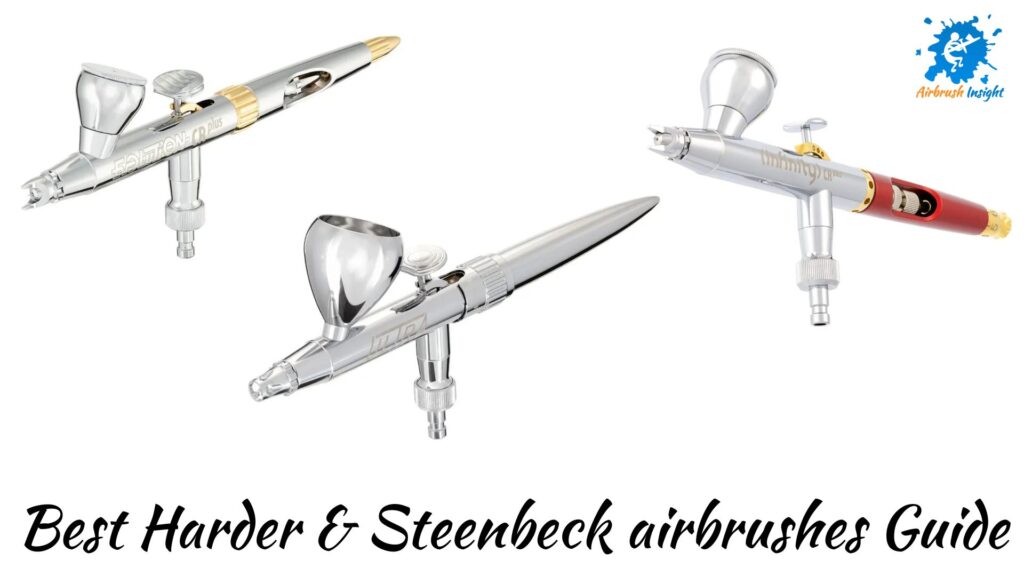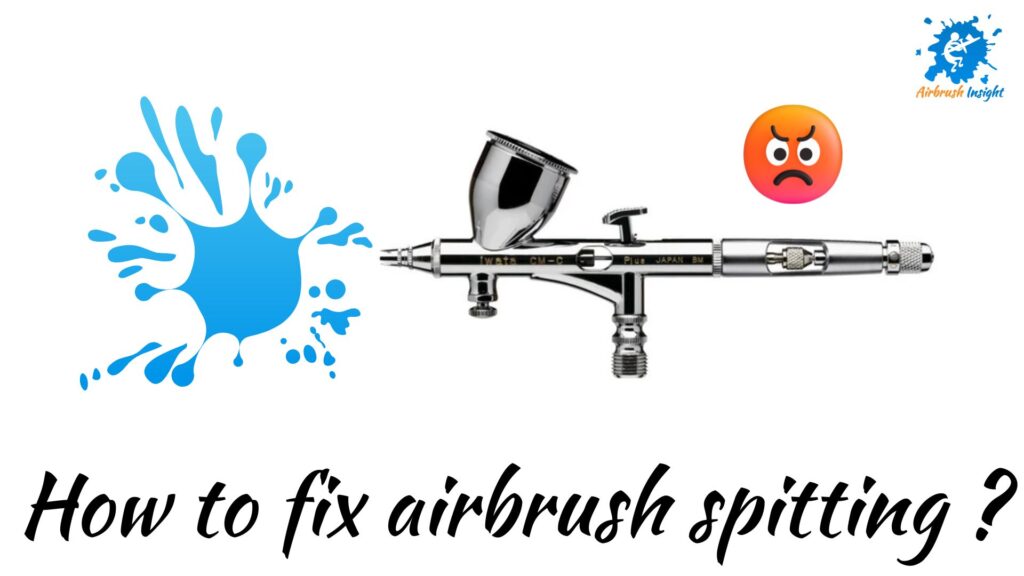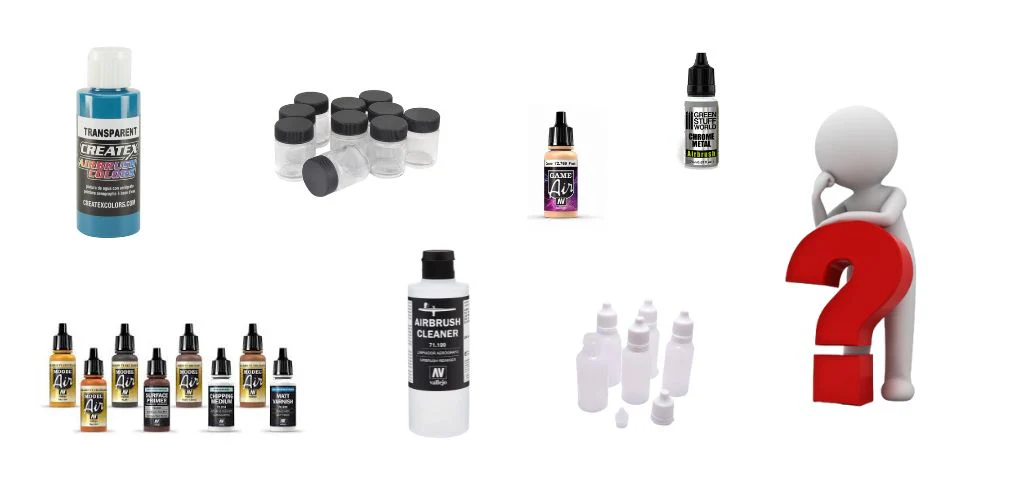When you get serious about painting miniatures, models, or decorative objects, the question quickly arises: which airbrush should you choose? The Japanese brand is renowned for the reliability of its models, their precision, and high-quality finishes. But with so many options (Neo, Eclipse, Micron, Revolution…), it’s easy to get lost — we’re here to help you find your ideal Iwata airbrush.
Here are the best IWATA airbrushes:
| Top | Model | Type | Estimated Price | Rating (/5) |
|---|---|---|---|---|
| 1 | Eclipse HP-CS | Gravity – 0.35 mm | ~185 € | 4.8/5 |
| 2 | Neo CN | Gravity – 0.35 mm | ~115 € | 4.5/5 |
| 3 | Revolution HP-CR | Gravity – 0.5 mm | ~149 € | 4.4/5 |
| 4 | Hi-Line HP-BH | Gravity – 0.2 mm | ~270 € | 4.6/5 |
| 5 | TRN2 / HP-TH | Trigger – 0.5 mm | ~247 € | 4.2/5 |
| 6 | Micron CM-C Plus | Gravity – 0.18 mm | ~698 € | 4.9/5 |
TOP 1 – Iwata Eclipse HP-CS Airbrush: The Most Versatile

- Dual-action with 0.35 mm nozzle
- Gravity feed, integrated cup
- Versatile: basecoats, lining, gradients
- Compatible with most paints without heavy thinning
- Easy to clean thanks to drop-in nozzle
- Widely used, spare parts are easy to find
The Iwata Eclipse HP-CS is often the first real upgrade for painters looking for a reliable, precise airbrush that can do it all. With its 0.35 mm nozzle, it covers a wide range of uses: priming, basecoating, gradients, shading, fine lining. Its design makes it quick to clean between colors, making it a trusted choice for long sessions or batch painting. Many Warhammer miniature painters use it as their main airbrush due to its performance, accessibility, and durability. You can also see wich are the best airbrush compressor guide.
| Pros + | Cons – |
|---|---|
| Sprays most paints without thinning | Less suited for ultra-fine lines |
| Easy to maintain, tool-free nozzle | Needs a slightly more powerful compressor |
| Large user community = tutorials, spare parts | Fixed cup, longer cleaning when changing paint types |
| Highly versatile | More expensive than entry-level models |
Our opinion: An excellent all-purpose main airbrush with no fuss.
Conclusion: 4.8/5
TOP 2 – Iwata Neo CN Airbrush: The Best for Beginners

- Dual-action with 0.35 mm nozzle
- Gravity feed, two interchangeable cups
- Low pressure operation, ideal with a small compressor
- Affordable price, perfect for beginners
- Good precision for detailed work
- Compatible with thinned acrylic paints
The Neo CN is the recommended airbrush for those who want to start without breaking the bank. Despite its entry-level price, it allows you to do fine work, gradients, and priming with good control. It handles paints like Citadel or Vallejo Model Air (slightly thinned) well and doesn’t require a high-end compressor. Widely used by Warhammer hobbyists to test airbrushing without risk, it offers excellent value for money.
| Pros + | Cons – |
|---|---|
| Low price for real IWATA quality | Less durable over the long term |
| Works well with low-output compressors | Less suited for large surfaces |
| Easy for beginners to use | Not ideal for thick paints |
| Two cup sizes included | Less precise than higher-end models |
Our opinion: The best entry point into the Iwata world for learning on a budget.
Conclusion: 4.5/5
TOP 3 – Iwata Revolution HP-CR Airbrush: Best Value for Money

- Dual-action with 0.5 mm nozzle
- Gravity feed, fixed 9 ml cup
- Robust body, good grip
- Good flow rate for priming and fast basecoats
- Simple maintenance with accessible parts
- Suitable for acrylics and varnishes
The HP-CR is a model appreciated by painters who want a solid, reliable, and efficient tool for most tasks. With its 0.5 mm nozzle, it easily handles thicker or lightly thinned paints. It’s ideal for fast work such as priming, basecoats, or varnishing, while still allowing decent finesse for intermediate layers. Often recommended for those looking to upgrade from a Neo without moving into overly technical models.
| Pros + | Cons – |
|---|---|
| Great balance between price and performance | Less suited for ultra-fine details |
| Good paint capacity | Heavier than other models |
| Works well with varnishes and thick paints | Less precise than an Eclipse or Hi-Line |
| Spare parts are easy to find | Fixed cup = slightly longer cleaning |
Our opinion: A solid mid-range choice, reliable for regular use.
Conclusion: 4.4/5
TOP 4 – Iwata Hi-Line HP-BH Airbrush: Best for Detail Work

- Dual-action with 0.2 mm nozzle
- Gravity feed, 1.8 ml cup
- Built-in MAC valve to adjust air pressure in real time
- Designed for detail work and fine effects
- Ultra-precise paint flow adjustment
- Lightweight body and good ergonomics
The Hi-Line HP-BH is for painters seeking the highest level of control. With its fine 0.2 mm nozzle and integrated MAC valve, it lets you fine-tune flow and pressure on the fly to handle very smooth transitions, blending effects, or sharp lines. It’s highly praised for high-level miniature painting, NMM highlights, or extremely precise areas like faces or freehands. It’s a technical tool, best for users who already master airbrushing or want to specialize.
| Pros + | Cons – |
|---|---|
| Ultra-fine control thanks to MAC valve | Not suitable for large surfaces |
| Fine nozzle ideal for extreme detail | Requires perfectly thinned paint |
| Great for complex effects (fine gradients, smoothing) | Needs regular and careful maintenance |
| Excellent ergonomics and precision | High price for occasional use |
Our opinion: An excellent tool for detail lovers and advanced techniques.
Conclusion: 4.6/5
TOP 5 – Iwata TRN2 / HP-TH Airbrush: Most Comfortable Trigger Option

- Dual-action with pistol-style trigger
- Large 0.5 mm nozzle
- Suction feed (HP-TH) or gravity feed (TRN2)
- Ideal for large surfaces, fabrics, or scenery
- Natural grip for users familiar with spray guns
- Robust and durable model
The TRN2 (trigger + gravity feed) and HP-TH (trigger + suction) are designed for long sessions or users accustomed to spray gun ergonomics. Their trigger allows smooth, progressive control, and the large nozzle makes it easy to apply primers, varnishes, wide blends, or textile paint. Well-suited for those who find traditional trigger buttons tiring or unintuitive. Popular for custom work, decoration, or large miniatures.
| Pros + | Cons – |
|---|---|
| Maximum comfort during long sessions | Less precise for fine detail |
| High flow rate for quick paint or varnish coverage | Bulkier model |
| Good grip if used to spray guns | Requires more air, so needs a suitable compressor |
| Sturdy and reliable for heavy use | Not suited for miniature precision work |
Our opinion: Perfect for large projects or users who prefer a spray gun-style trigger.
Conclusion: 4.2/5
TOP 6 – Iwata Custom Micron CM-C Plus Airbrush: The Ultimate for Professionals

- Dual-action with ultra-fine 0.18 mm nozzle
- Gravity feed, integrated cup
- Built-in MAC valve for real-time pressure control
- Extreme control for ultra-detailed work
- Premium build quality, hand-assembled in Japan
- Used by professionals in miniatures and illustration
The CM-C Plus is built for experienced users who demand absolute precision. Every component is calibrated to provide the finest and most controlled spray possible. Its 0.18 mm nozzle enables microscopic lines, perfect for NMM, faces, ultra-subtle shading, or top-tier illustration work. It requires experience, perfect dilution, and meticulous cleaning. This is a specialist tool, made for those seeking the best possible result with no compromises.
| Pros + | Cons – |
|---|---|
| Unmatched precision for extreme detail | Very high price |
| MAC valve for maximum control | Requires flawless maintenance |
| Hand-assembled, flawless quality | Not suited for fast or rough work |
| Ideal for pro miniature painters and illustrators | Too demanding for beginners |
Our opinion: A precision machine built for demanding, experienced painters.
Conclusion: 4.9/5
Which IWATA Airbrush Should You Choose Based on Your Painter Profile?
- The Neo CN is ideal for a beginner with a small budget.
- The Revolution HP-CR suits a serious beginner or general-purpose use.
- The Eclipse HP-CS is recommended for intermediate users seeking versatility.
- The Hi-Line HP-BH is perfect for detail enthusiasts and precision painting.
- The TRN2 / HP-TH is great for those who prefer a trigger or work on large surfaces.
- The Micron CM-C Plus is aimed at experts or professionals needing extreme precision.
FAQ: Choosing and Using Your IWATA Airbrush
Which feed type should I choose: gravity or suction?
Gravity feed is ideal for small amounts of paint and offers better precision. Suction feed is useful for larger volumes or covering large surfaces.
What nozzle size is best for painting miniatures?
A 0.35 mm nozzle is the most versatile for basecoats, gradients, and lining. For extreme detail, go for a 0.2 mm or 0.18 mm nozzle.
Can I use a small compressor with an IWATA airbrush?
Yes, especially with models like the Neo CN or Revolution CR that operate at low pressure. Others, like the Micron or Eclipse, need a more stable and powerful compressor.
Should beginners buy a high-end airbrush?
No. It’s better to start with an affordable model (like the Neo or Revolution), learn the basics, and upgrade later if needed.
Are all IWATA airbrushes compatible with acrylic paints?
Yes, as long as the paint is properly thinned and the airbrush is cleaned after each session. Models with a 0.5 mm nozzle handle thicker paints better.
Which IWATA airbrush is the best all-rounder?
The Eclipse HP-CS is considered the best balance for painting miniatures, models, textiles, or decorative objects without sacrificing precision.
What pressure should I use with my IWATA airbrush?
Ideal pressure depends on the model and paint, but generally: 1.2–2 bar for fine detail, 1.5–2.5 bar for general work. The Neo works from 1 bar, while the Eclipse or Micron prefer stable 1.5–2 bar.
How do I clean my IWATA airbrush?
Rinse between each color with a suitable cleaner. For deep cleaning: disassemble the nozzle, needle, and cup, and clean each part with brushes, pipe cleaners, and cleaner fluid. Never force delicate parts, especially the needle and nozzle.
Conclusion: Which IWATA Airbrush Should You Choose?
Choosing an IWATA airbrush mainly depends on your skill level, intended use, and budget. If you’re just starting out, the Neo CN is an excellent entry point. For more regular and versatile use, the Eclipse HP-CS remains the go-to option — capable of handling nearly everything without compromise. More advanced users will prefer the Hi-Line HP-BH or Micron CM-C Plus for ultra-precise work. Finally, if you’re looking for trigger comfort or work on large surfaces, the TRN2 or HP-TH models will meet your needs.
The most important thing isn’t having the most expensive tool, but the one that fits your painting style best. A well-chosen IWATA airbrush will serve you faithfully for years.



